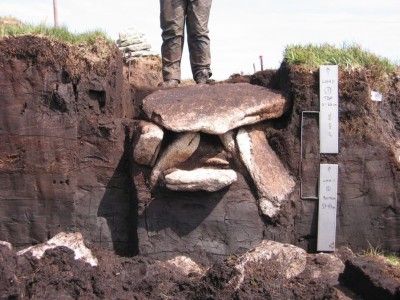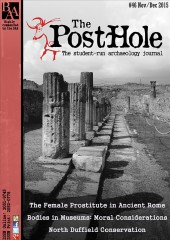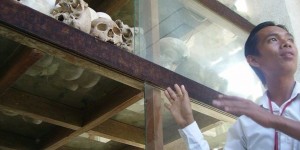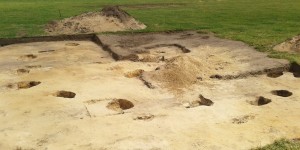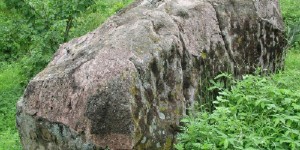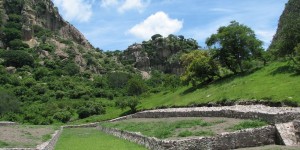It is with great pleasure that I write my first editorial as editor-in-chief for The Post Hole. I would like to give my enormous thanks to last year’s team, who have now left the journal, for their tremendous job in making it such a success. We certainly have some very big boots to fill, and I hope that we will be able to continue the magnificent work of our predecessors.
Initially, I would like to officially welcome our very promising new team members, as well as welcoming back some of the previous year’s team. I hope that this year will prove a good one for The Post Hole!
For November/December’s issue, we have a brilliant selection of articles, all of which were an absolute pleasure to read. In this cold and fairly grey month, there is nothing like an intriguing piece about dead bodies to brighten up the atmosphere! I am extremely happy to be able to release an issue which is brimming with such diverse and fascinating articles. So, here is a summary of our selection:
Firstly, we have an excellent investigation into the perceived social identities of female prostitutes living and working in ancient Rome. Here, Neil Ackerman from the University of Highlands and Islands, tackles the way in which these women were viewed and documented, as well as discussing the limitations of the predominantly male dominated research into this. Ackerman also stresses the need to consider our own biases when discussing gender identities; modern Western connotations of sexuality are not directly comparable to those held by an ancient Roman citizen.
Secondly, we have an insightful article written by Sophia Calugay from the University of Aberdeen, which thoughtfully lays out the contentious issues surrounding the display of the dead in museums and other public places. Calugay produces a synthesis of the debates and important questions regarding morality and ideas of personhood, while considering a variety of viewpoints including her own.
Our next article is the fourth submission from Brian Elsey. In this excellent piece, Elsey considers the archaeological investigations made by the North Duffield Conservation and Local History Society, unveiling the details of an excavated circular Iron Age feature. A number of engaging images are used to illustrate this interesting and comprehensive summary of the excavations.
Finally, we have two articles submitted by Professor Arnaud Lambert about the fascinating site in Chalcatzingo, Mexico. The first article is a brilliant investigation into seven new cup-marked stones from this area. Lambert provides an excellent description of their spatial and chronological settings, and draws some interesting conclusions about their function in rituals.
Lambert’s second is a brief recording and discussion of the possibility of a sculptural fragment currently residing in a caretaker’s building in Chalcatzingo being further evidence of a ball court at this site. There are similar finds from sites elsewhere, and these are also historically documented from this time, so it will be interesting to see how this may develop.
Before finishing here however, I would like to describe some amazing discoveries recently published which excited me closer to home. This is the Whitehorse Hill’s Early Bronze Age cist burial on Dartmoor, which is now considered one of the most important burials of its age in the South-West; the burial contained a stone cist box, inside of which were the cremated remains of a young woman, along with an unprecedented amount of spectacularly preserved artefacts. Due to the positioning of the burial in what would later become a raised peat bog today, organic evidence has been incredibly well-preserved.
Her cist had been packed with moorland grasses, suggesting a late summer or early autumn burial. Alongside the cremation was a woven lime and bark basket, the materials for which had undergone processing to make them suitable for weaving. Having been painstakingly opened in a laboratory, the basket was found to contain two pairs of large wooden stud plugs, representing some of the earliest evidence of woodturning. It is tempting to imagine that these may have been worn through the ears or lips, as we see in piercing trends today. The basket also contained over 200 shale, clay, tin and amber beads, as well as a flint flake. Additionally, a delicate woven sash was found patterned with triangles of calfskin, as well as a tin studded cow hair armband.
More recently, the previously unidentified animal pelt which surrounded the cremation was matched to belonging to none other than that of a brown bear. When confronted with evidence like this, it is hard to resist conjuring up an image of a warrior princess figure! I hope that there will be many more finds of this nature from Dartmoor in the future. The above information on the Whitehorse cist was taken from Jones, A. et al. in their 2014 article about the site.
I would finally like to show gratitude to Sam Galison for providing us with our splendid cover image of the columns in Pompeii.
Don’t forget, if you would like to share any of your thoughts, research or experiences with the archaeology community, then please submit your work to us at submissions [at] theposthole.org to appear in next month’s article. For guidance on submission, please visit our website at www.theposthole.org/authors for more information about this.
All the best,
Freya Lawson-Jones
Editor-in-Chief
editor [at] theposthole.org
Bibliography
- Jones, A., Marchand, J. Sheridan, A. and Straker, V. (2014) Bronze Age Grave on Whitehorse Hill. British Archaeology. 139, 16-23
Online sources
- Day of Archaeology (2015) ‘uncovering the Mysteries of a Bronze Age burial’ http://www.dayofarchaeology.com/tag/whitehorse-hill/ [accessed 12/12/15]


